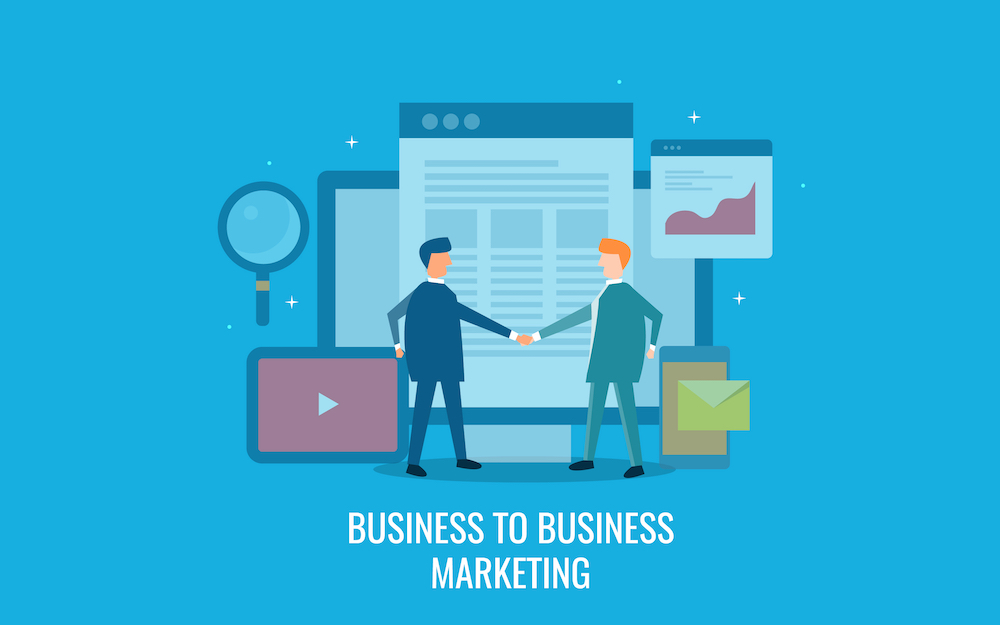A Definitive Guide to Get Started on B2B Email Marketing

In the B2B segment, email marketing is a great tool to start a conversation with other businesses and their decision makers. Persuading customers and building trust with them is an important aspect of marketing, and emails are a significant channel for doing that.
On average, a professional checks his email 15 times a day, or after every 37 minutes. The fact that professionals review their emails so often gives you ample time to start a conversation, build trust, and provide value.
Understandably, not all marketing efforts are targeted towards selling. They are also done to educate the audience, and what better way to deliver value than to deliver it right in their inbox?
Like any other type of marketing, B2B email marketing also requires a well-thought-out strategy backed by research. It’s not a cakewalk for sure, but if done right, email marketing can help you generate a ton of business.
In this article, we will dive deep into what B2B email marketing is, and how you can get started right away.
We have actionable tips per minute, so make sure you have a notepad ready with you, let’s begin!
What is B2B Email Marketing?
With B2B email marketing, you target your emails to businesses and decision-makers.
93% of B2B marketers use email marketing as their go-to strategy, and the numbers have been increasing.
It’s important to understand that with B2B, you’re not targeting individual customers. So, confusing it with B2C or assuming both of them run along the same lines for email marketing would be wrong. Both of them are unique and require different approaches to see success with emails.
For example, if you want to persuade an individual customer to buy a product, you would like to connect with them, build trust, and use emotion. But with B2B, along with using emotion and storytelling, logic also plays a great role.
With B2B email marketing, you need to plan your emails because you’re targeting businesses who are very careful of the investments they make, and where they focus their attention. So, here guiding with logic along with emotion would be wise.
This means that until you can persuade your potential customer that investing in your product or service is logical and the best for their growth, the sale won’t happen.
B2B requires a more careful and calculated approach to email marketing, where you should be aware of your target businesses.
Now, we know what you’re thinking.
Is email marketing worth all this hassle?
It most definitely is, let’s see why!
Why is B2B email marketing beneficial?
Ideally, you should invest in the channel where your audience is most active. While social media has taken a hit in this space, for the B2B segment, emails are among the most effective ways to connect with and convert your audience.
Now that we’ve talked about what email marketing is let’s address why it’s beneficial for your business.
89% of marketers use email as the primary channel for generating leads.
There are many reasons why you should invest in email marketing, but here are our top 3:
1. You own your list
Social media platforms allow you to create a profile for free. You spend time building your presence, marketing your channel, and drafting strategies to grow your profile, but your account gets suspended, or the social media platform gets taken down from your country one day. Now what?
With social media, there’s a lot of uncertainty. You invest time and money in building your presence, which is at an all-time risk. However, that’s not the case with emails.
Once you have an email list, it’s yours to keep. You can download it and keep it safe on your hard drive for future and present use. It’s an owned asset, which can help grow your business.
2. Educate your audience
While selling is one aspect of using email marketing, your audience will only buy from you once they trust you. To gain their trust, educating, providing value, and solving problems are important.
With an email newsletter or resource list, you can educate your audience. Grab a common pain point, address it, provide innovative solutions, and redirect them to a helpful blog or resource on your website.
Through this, you’ll help solve their problems, and if they find it valuable, they will start trusting you. When you provide value regularly, they will start looking up to you as a thought leader, and thus as a solution to their problems.
3. Greater conversions and ROI
Email marketing has an ROI of a whopping 4400%. That’s a crazy percentage for any marketing channel, and it’s the primary reason why many B2B businesses are now focusing their attention on email marketing.
This is because emails allow you to nurture your audience. You can engage with them, offer packages, build trust, and convert them from subscribers to customers. So, we can conveniently say that email marketing is one of the best investments for B2B businesses.
A step-by-step guide to getting started on B2B email marketing
Email marketing is beneficial, yes, but the road might look a little challenging. Well, it doesn’t have to be, you can piece it together with the right strategy to reap benefits for years to come.
Here’s a simple 5-step guide to help you get started on B2B email marketing.
1. Build your email list
You need an email list to send out emails to your audience. Many people make the mistake of buying an email list which should be avoided because that’s probably not your audience and you don’t have the permission to send them emails.
If you’re landing in their inbox, you’re a guest. With a bought email list, you’re an uninvited guest which can cause more harm than good. So, you need your audience’s permission before you send an email.
Another mistake people make while building their email lists is to include emails from business cards and LinkedIn profiles. Again, you don’t have permission to email them.
By permission, it means that they should give you their emails themselves. That way, if you send them one, they will be aware of it.
Now, we know what you’re wondering.
Why will people give you their emails?
To grow your email list, you need to provide value.
There are multiple ways to get people to join your email list voluntarily.
Let’s look at some of these:
Use a lead magnet
A lead magnet is a free resource you provide in exchange for an email address. It’s an educational piece of content that helps your audience gain more awareness or solve a problem.
These include eBooks, checklists, whitepapers, free masterclasses, case studies, webinars, etc.
However, not every lead magnet works well in attracting email addresses.
A good lead magnet is actionable, easy to consume, relevant, and immediately available to your audience.
Including videos in emails can boost click-through rates by 300%.
For your audience to reach the lead magnet, you can use an opt-in form on your website. An opt-in form informs your audience about the benefits of using the lead magnet. It uses persuasive copy to compel the user to submit their email addresses in return for a value bomb.
Learn more about creating a compelling opt-in form here.
Apart from the website, you can run ads that take the audience to this opt-in landing page. You can also share it on social media, so more people can sign up for it, expanding your email list.
It’s one of the best ways to build your email lists with permission.
Product updates and news
Tell your audience to sign up to your email list, so they’re the first ones to receive an alert when you announce new products or news about the brand. These are quite effective when the brand has an established authority on digital media, and people want to know when they can grab one of their products soon.
This can be through the website or social media.
Persuade them by being straightforward
Another great way of getting people to sign up for your email list is to be clear with them. Tell them you’re going to share never-heard tips and tricks about the industry, offer free resources, some exclusive discounts, and product alerts to those who sign up.
For example, if you provide consultation services to SaaS companies, then give them a few tips on a social media post and tell them they can sign up for more of them through your email list.
Once you start your newsletter, you can also give your non-email audience sneak peeks into the newsletter content. This will instill Fear Of Missing Out (FOMO) which will compel people to sign up for your list.
You can share this through your website, social media, and even ask your thought leaders and employees to talk about it in industry groups, and on LinkedIn to promote it.
These three ways can help you build your email list the right way. Moreover, you will have people who are genuinely interested in hearing from you than people who don’t even know who you are through bought email lists. Having 100 interested people is far better than having 1,000 unaware ones.
2. Choose an email marketing service
Before you begin your email marketing efforts, it’s essential to have software in place. Email marketing services like MailChimp and ActiveCampaign help you set up campaigns, target customers and automate processes. They also allow you to track the analytics to understand what’s working and what changes you need to make.
There are many tools in the market, so make sure you consider these things before you invest in an email marketing software:
Mobile optimization
Today, many professionals read emails on their mobile, so mobile optimization is a critical aspect to consider when choosing an email marketing software. If someone opens your email and is not shown the message entirely, they’ll bounce right off so ensure that the software has mobile-friendly templates.
Integration
Your Customer Relationship Management software or CRM is a significant part of your marketing efforts. If your email marketing software integrates with the CRM, it can save up a lot of time on manually updating email lists and sending them. This integration will automatically manage new updates, customer data, and ensure content is sent out, keeping the latest updates in mind.
Automation and response handling
If you’re starting with email marketing, you will have a small email list, so it’s easy to respond to people. However, as you proceed, your email list will keep expanding with new people added every day. With this, it will be challenging to reply to emails individually. So, the email marketing software should have an email autoresponder so you can set responses at auto-pilot.
With these pointers in mind, you can choose your email marketing software from the list here.
3. Start creating content
Content is a very crucial part of email marketing. You will have to create content consistently. If you decide on sending one email per week, it cannot be missed. So, it’s a commitment, but thanks to email marketing software, you can automate the entire process and set all the content, weeks in advance.

Don’t be too frequent with your content. Spamming is not the right way, balance the frequency, and focus on the quality of content more than quantity.
As soon as someone signs up to your email list, a welcome email is important. This is because it sets out the rapport in the first email and tells your audience what they can expect from them in the future.
Here are some things to keep in mind for the email content:
- Keep your emails clear from fluff. Make it concise and clear.
- People don’t have a lot of time to read your email, so make it short and skimmable.
- Use an enticing subject line and use personalization.
- Experiment with formats and subject lines to see what works.
- Ask an open-ended question in the end, so they reply.
- Write in the first person, using the word ‘you.’
- Reflect your brand personality in your emails.
- Use an attractive header or graphics which align with your brand colors and fonts.
The truth is, everyone’s inbox is overflowing with emails. If you want them to open, read, and take action from your email, you need to pay attention to the content.
Respect your subscribers and express gratitude. Campaigns and sequences for your email marketing efforts should center around content. While targeting and segmentation play an essential role, content holds it all together.
Tuesday and Thursday are the Best Days to Send Emails.
4. Segment your email lists
Segmentation is the act of breaking up your subscribers into smaller, more targeted groups. This is important because categorizing your email list will help you send more personalized and relevant emails to your subscribers. It’s one of the best ways to optimize your content, which results in higher conversions.
With segmentation, you can send a particular type of content to a targeted set of people who are more likely to be interested in that. Through this, you will also understand what content and subject lines work with which subscribers.
For example, some of your customers might like to hear about your sale offers and packages, while others may have only signed up for the educational content.
Segmentation will also help you reduce the number of unsubscribers and ensure a high open-rate.
Here are a few ways how you can segment your email lists:
- Draft different customer personas based on the data you have about them.
- Use your email marketing software’s segmentation feature.
- Prepare a survey to understand different needs.
- Analyze your subscriber’s responses.
- Study your customer’s past purchases so that you can send them recommendations for similar items.
- Understand your subscriber’s position in the sales funnel.
Email list segmentation is not very difficult. With a bit of effort and tactics, you can perfectly work out segments because you will be able to send much-targeted emails after that.
5. Focus on the analytics
If you’re investing time and effort in your email marketing strategies, you need to analyze metrics to see if those efforts yield results. One of the best ways to increase conversions and loyal customers is by analyzing metrics.
It will tell you what’s working, and how you need to improve your email marketing strategies. It will also tell you the kind of relationship you have with your subscribers.
Here are some metrics you should pay attention to:
Open rate
Your open rate will tell you how many people open your emails. If you get a low open rate, it means you have to work on your subject lines. The subscribers don’t feel engaged or connected enough to open your emails. To regain their attention, you’ve got to hook them with value and persuasive copy.
Unsubscribe rate
Your unsubscribe rate will tell you how many people bounced off your list. This number indicates that you need to rework your email marketing strategies and focus on your copy a lot.
Click-Through Rate (CTR)
The CTR will tell you how many people clicked on a link you included in the email. If the CTR is low, it means the call-to-action, and the copy is not compelling enough. You need to highlight the offer and convey the messaging more effectively.
37% of brands are increasing their email budget.
List growth rate
This will tell you how much your email list has grown. A low list growth rate means that you need to work on your lead magnet or opt-in strategies to sign up more people to your email list.
There are a lot of other metrics you can track. However, these are the most important ones. Paying attention to your email analytics can tell you specifics about what’s going wrong and how you can fix it.
Conclusion
B2B Email Marketing is worth the investment, and if you’re still missing out on it, you may need to rethink your marketing strategies. Selling to businesses is not easy. It requires some serious research, targeting, understanding, and personalization to convert them.
However, with email marketing, you can reach out to them in a much more professional, direct and above all efficient manner..
With the right strategies, you can start on the right foot and make the most of your email marketing efforts. Over time, experiment with your plan, and you will close qualified leads faster, thus growing your business.
Happy emailing!
Sources
- lxahub: Email Marketing Trends 2022
- Benchmark: Email Marketing Statistics
- Hubspot: Email Marketing Statistics



